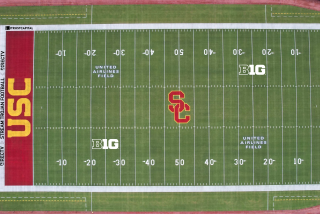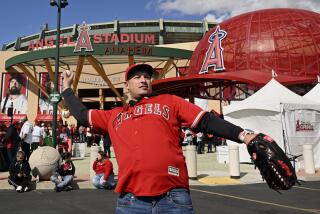Cigarette Advertising Will Give Up Box Seats : Settlement: Philip Morris agrees to move images in sports stadiums and arenas that were appearing in TV broadcasts.
- Share via
Philip Morris, the maker of Marlboro cigarettes, agreed Tuesday to move advertisements in professional sports stadiums that the Justice Department said violate a government ban on TV cigarette advertising.
The Justice Department said Philip Morris, the nation’s biggest tobacco company, placed the ads in stadiums so they would appear on TV during game broadcasts--thereby violating the 1971 ban.
The agreement affects five basketball arenas and stadiums used by 14 football and baseball teams, including Anaheim Stadium, home of the California Angels.
Marketing experts viewed the agreement as the first step in removing all cigarette company images from television. They said cigarette company sponsorships of televised events that are not part of the agreement, such as auto racing, could come under scrutiny, potentially upsetting the economics of sports.
“The momentum is there,” said Jed Pearsall, a marketing analyst with Performance Research, a company that measures consumer response to advertising.
Although it did not comment on any pending investigations, the Justice Department made it clear that the agreement is intended to put the entire sporting industry on notice.
“This should send a message to arenas, tobacco manufacturers and to broadcasters that the Department of Justice intends to enforce” the ban, said Brian Eisen, a an attorney for the department in Washington.
Philip Morris said in a statement that its advertisements did not violate the ban. It noted that the agreement applied to “permanent advertising in stadiums.” The company said that since October it has voluntarily repositioned, but not removed, the signs at professional sports arenas.
The company said its ads are “intended to reach the large number of adult smokers who attend sporting events” and that “the television pickup these ads may have received in the past is incidental.”
But Eisen said there was clear evidence that some ads had been placed with TV coverage in mind. For example, he said, Madison Square Garden in New York had sent Philip Morris reports on how much TV time its cigarette ads received during New York Knicks games.
The Justice Department settled charges last month that Madison Square Garden had violated the ban, he said. That case led to the broader investigation of Philip Morris.
Frank Hunger, assistant U.S. attorney general for civil rights, cited other examples of what the department viewed as violations. He said that in the New Orleans Superdome, Philip Morris had a Marlboro sign that “was there so that there was definite coverage every time an extra point was kicked.” He said San Francisco’s Candlestick Park had a similar sign.
The Justice Department has not told Philip Morris which ads to move. Asked for a likely example in Southern California, Eisen said: “I am familiar with Anaheim Stadium, and the left centerfield [Marlboro] sign has appeared during the action of a game. Such signs are prohibited under the decree.”
Marketing experts said the amount and value of stadium advertising has skyrocketed with the proliferation of TV channels airing sporting events.
At New York’s Shea Stadium, Philip Morris reportedly spends $350,000 to rent a single billboard--an amount “not justified by the number of people attending games,” said Bruce Silverman, president of Asher/Gould, a Los Angeles advertising agency. “They clearly know what they are doing,” he said.
Philip Morris would not say how much it spends on stadium advertising and the Justice Department had no figures. Marketing experts said the value of such advertising can be significant.
Joyce Julius & Associates, a firm that tracks advertising during sporting events, said that during this year’s Sugar Bowl in the Superdome, stadium advertising for Marlboro appeared on TV for 32 seconds. The consulting firm said that exposure was worth $266,000, based on the cost of a 30-second commercial for the 3 1/2-hour event.
Eric Wright, a vice president with Joyce Julius, said TV exposure is not a sure thing, because it depends on how the game unfolds and how the TV cameras follow the action. “It is really hit-or-miss,” he said.
Hunger declined to comment when asked if the department is investigating advertising by other tobacco companies or auto racing sponsorships.
“We have to take it one step at a time,” he said.
More to Read
Go beyond the scoreboard
Get the latest on L.A.'s teams in the daily Sports Report newsletter.
You may occasionally receive promotional content from the Los Angeles Times.










